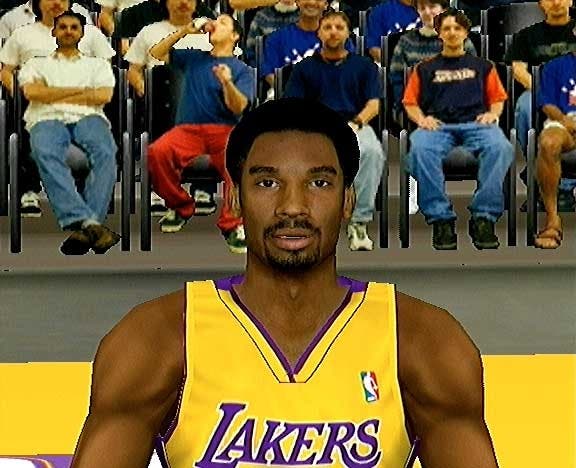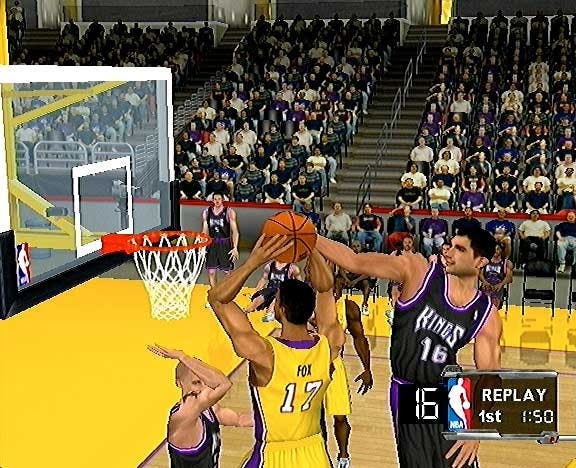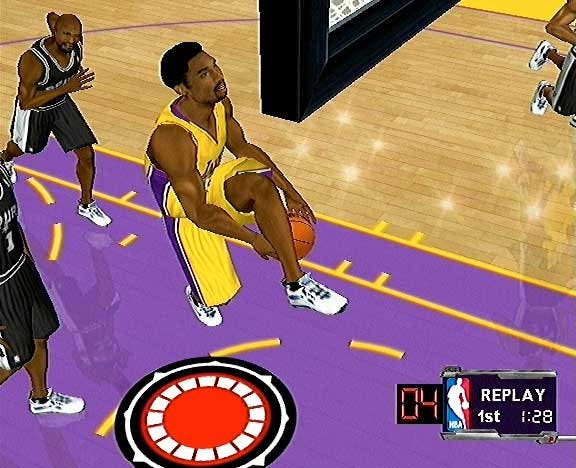NBA Courtside 2002
Review - a comprehensive basketball game with sim and arcade stuff, and a good one at that

Slam Monk
Football, we understand. Any monkey in a green suit can tell you whether or not the ball has crossed the goal line, and whether that two-footed stud-platter you just served the right back was legitimate or not - in fact we might even suggest employing monkeys as a cost-cutting solution to FIFA's current financial problems - but put that same monkey, or indeed your average European, on a shiny wooden court with a bunch of seven foot men in vests and shorts, and before long he won't know where he is, what he's doing or what his name is.
Basketball games are not all the same, whatever you may think, but sometimes they take the best bits of other games and serve them up better; if only football games could still do that. NBA Courtside 2002 offers you all the statistical authenticity of its EA-developed rivals, a simulation of basketball frankly unmatched by its main competitor, and at the same time introduces an arcade mode to rival the almost brilliant NBA Street in terms of 'largeness'. It's like a big measured V-sign pointed in the general direction of John Riccitiello and his cohorts at Electronic Arts.
Coupling all of the above with a unique and rewarding control system, some great graphics and wonderfully balanced AI, NBA Courtside 2002 is so close to being the pinnacle. A few scant remaining problems conspire to spoil the overall experience, although frankly it's still great. If you like basketball and you bought a Cube, this is the game to get. Want to know more? Keep reading.

Coming Straight Outta Leftfield
NBA Courtside 2002 was released in Europe last Friday, three weeks after the Cube itself stormed the charts, and as Nintendo are sadly no longer best buddies with developer Leftfield, it is probably the last Courtside game we'll see. So why is this one worth adding to your collection?
Well, it's comprehensive and diverse. That's what I like about it. I may not care a jot whether it's statistically accurate, nor whether the players resemble their real-life counterparts - although it is and they do - but give me the option to build my own basketball team from scratch, assigning attributes and giving them all funky names and horrendously ugly mugs, and I'm happy. Give me the opportunity to take them onto the practice court and check out their moves, and I'm hooked. Let me throw them into the mix with professional basketball teams, or take them out onto the streets to compete in the ghetto with real backstreet ballers, and I can't get enough. Or just let me pick any team I like and do the same with them. You know it makes sense.
There's also a unique and rewarding control system. How can it be both? You'd think with a decade or so of experience EA might have perfected that by now, and at first glance it doesn't seem all that interesting or different. The left analogue stick handles the movement, while the whopping great A button is your jump shot or block, depending on the situation. The B button passes or steals, the X and Y buttons produce some dainty tricks to outwit the opposing defence, and the shoulder buttons (L, R and Z) get the adrenaline pumping, enable you to crouch or back into a defender and call for set plays. This is quite complex to begin with, but you soon get the hang of it.

Deeper
To really do some damage though, you need to pay attention to the other bits of the pad, and using buttons in combination. First of all, if you clutch the adrenaline-boosting L button or one of the trick buttons while you pass or shoot, you'll either toss it to the furthest player up the field or execute a different move to the one you would have done were you just giving A or B a tickle. If you delve a little deeper and trot about the training court for a bit, you'll also discover that the d-pad lets you set your offensive and defensive positions on the field, too.
But the real shocker is the C-stick. If you can get the hang of it, you can use it to play the ball between players, and if you can master the action of running one way while tricking and tossing the ball in the other direction with the C-stick, you will outfox even the most monolithic of defences. Not content with that, you can also feign shots, pass, shoot and dunk the ball in countless numbers of ways, and the animation is intricate enough to illustrate whatever action you take from whatever position you're in.
Graphically the game is extremely impressive, although sometimes a lack of animation can be a touch frustrating. I found myself wincing whenever the ball went off the court and a player ran to fetch it, only to twirl round on a turntable without his feet moving, but overall the level of detail and number of different animations makes for a very varied spectacle. Graphics form an extremely important part of any sports simulation or arcade game - they're the glue that holds the whole mess of sport, strategy and occasionally balls-out excitement together - and the courts, the photo-realistic blanket of spectators, the sight of players waiting impatiently on the subs bench and watching the basket sway up and down as a player hangs from it in jubilation is great. The ball has realistic physics too, and the clear black lines can be seen against the brown exterior as it spins in the air.

Odds And Sods
Equally impressive is Leftfield's delivery in the sound department. Trainers (or sneakers) make that incessant high-pitched squeak as the players dart around, and the crowd roars in time with the action. The ball thumps and squeaks, the net swooshes and the frame balks as it takes another heavy blow. It's all good.
Trying out everything in the options menu will take you an eternity. All manner of fouls, outs, time violations and general rules can be toggled on and off, and you can even change the way the C-stick behaves. During a match you can change to any one of six camera angles, you can adjust strategies and view statistics, and you can make substitutions or watch an instant replay.
Any game which takes this long to explain is obviously very complicated, and for some that will be a problem. The endless hours you can pour into the Season Play mode, and the time you can waste on fine-tuning your side, honing your skills or just plain learning the control system to begin with may get the better of you. This is a long haul, like a basketball RPG with things to learn throughout and intricacies to uncover. It's almost the Pro Evolution Soccer of basketball games, but at times the AI is a little too easy to overcome. And of course for some the 'thrill' of watching humongous male athletes swooping down from the middle of the court to bury a slam dunk will leave them unimpressed. However, many of those people can happily turn to the game's arcade mode, which endows players with over the top abilities and souped up stats, and lets you take advantage of hot spots from which high-point-high-risk shots can be attempted.
Conclusion
There's so much depth to NBA Courtside 2002 that you could stick some water on top and call it an ocean. In the few weeks we've had it, the game has grown and grown in promise, and although admittedly a slow starter, it delivers the goods comprehensively. As for the gameplay dynamic, it's feels and plays like basketball, and you can even take to the courts with four actual players if you feel like it.
If you like to touch up your ball instead of beating it with a studded boot, and you want a suite of features which makes NBA Live 2002 look like an empty shell of a game, then Courtside should be your first port of call.

